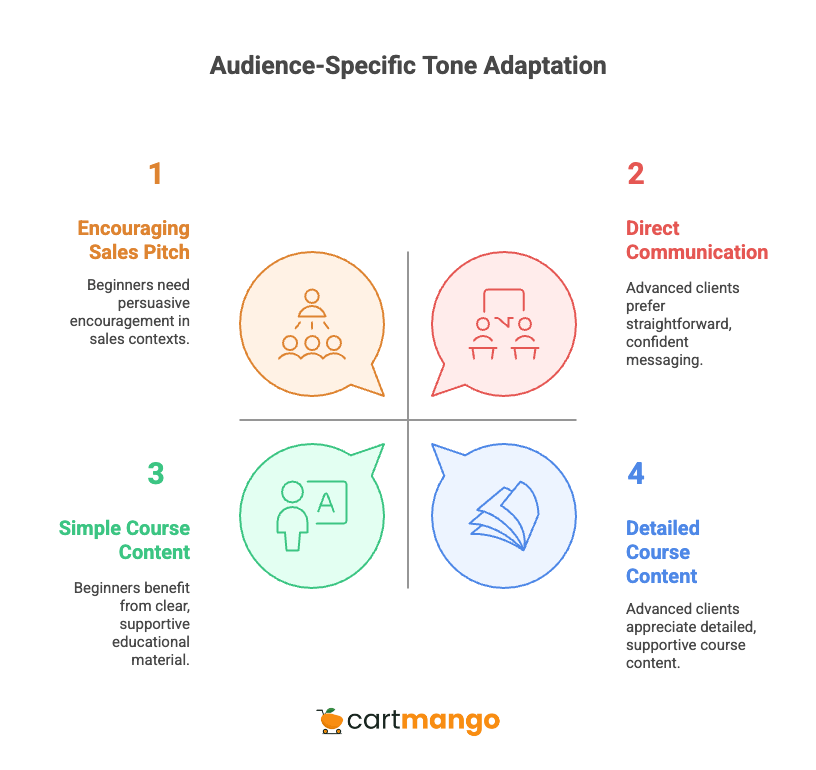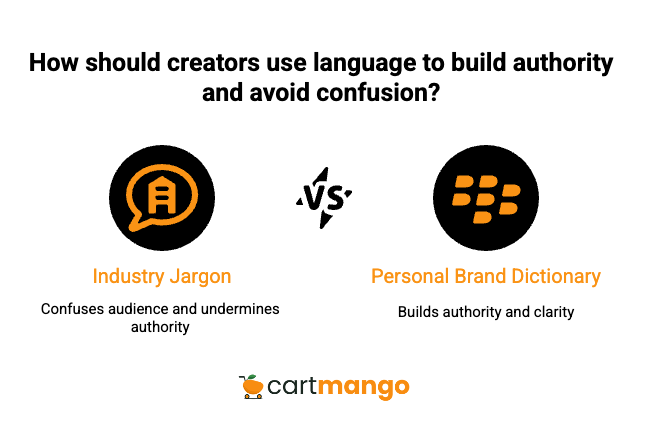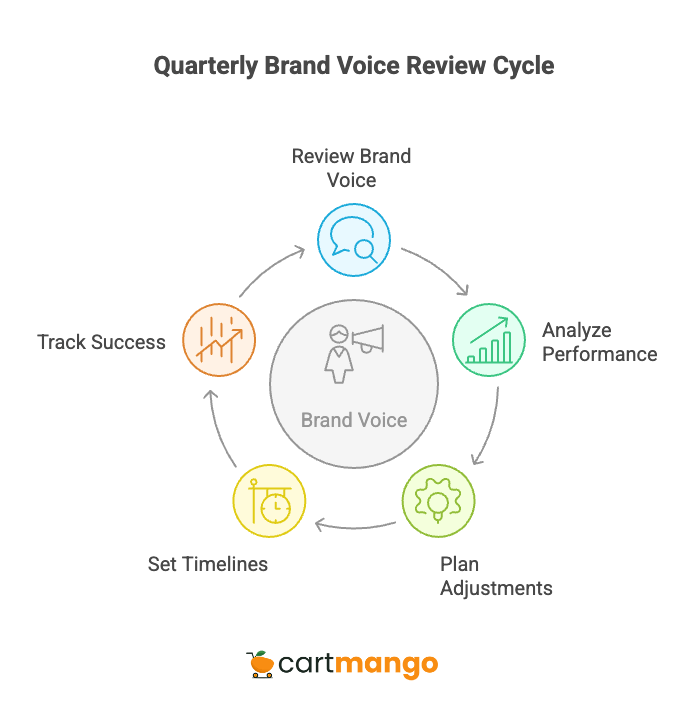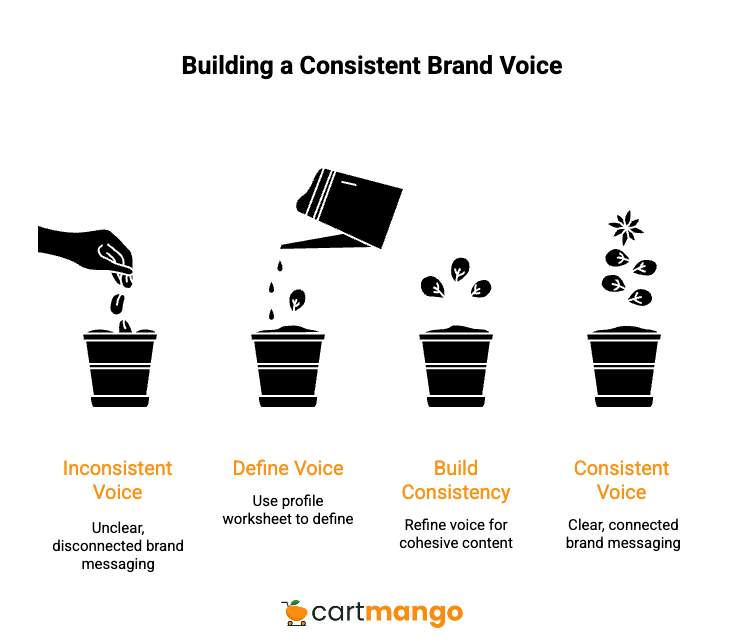To jump straight to the Voice Adaptation Matrix, go here.
To jump straight to the Brand Voice Profile Worksheet, go here.
–
Your Brand Voice Matters (more than you think)

Your voice sounds different across platforms. Your students get confused. And potential clients slip away before they even understand what you offer.
28% of customers stop buying from a company if they get frustrated by confusing or contradictory brand messages (source). That’s not just a number. That’s real revenue walking out the door because your brand voice feels scattered.
Conversely, solo entrepreneurs with defined brand guidelines can see more sales.
Your brand voice is about creating that warm recognition when people hear from you, like getting a text from your best friend.
When your voice is consistent, your audience knows what to expect:
- They feel connected.
- They trust you more.
- And trust is the foundation of any successful business.
In this post, you’ll discover how to create brand copywriting guidelines that work for independent creators like you.
What Are Brand Copywriting Guidelines?
Think of them as your personal communication rulebook. They help you speak consistently whether you’re writing course content, social posts, or client emails.
Corporate guidelines are thick binders gathering dust. Yours should be different. They need to be streamlined, personal, and flexible enough to grow with your business.
The key difference?
Personal brand guidelines focus on authenticity rather than corporate consistency. Your personality becomes your competitive advantage.
The Brand Voice Framework for Solo Creators
1/ Personal Brand Voice & Authenticity

Finding your authentic voice is not always easy. Many creators try to mimic others and lose their unique spark. I encourage you to spend time reflecting on how you naturally communicate.
Try recording yourself explaining your course topic to a friend. What words do you use? What tone feels natural? Write down three personality traits that describe your style.
This exercise helps you build a brand voice that feels true to you and resonates with your audience.
I call this the “Creator Voice DNA” assessment. It’s about identifying how you naturally communicate when you’re not trying to sound like someone else.
Brand Voice Profile Worksheet
This worksheet helps you define your brand voice by filling in key personality traits, voice characteristics, and signature language.
Brand Personality Traits:
- Primary Trait: _________________ (e.g., Encouraging – “You’ve got this! Let’s break it down step by step.”)
- Secondary Trait: _________________ (e.g., Knowledgeable – “Based on 5 years helping 200+ students…”)
- Supporting Trait: _________________ (e.g., Approachable – “I remember struggling with this exact same thing…”)
Voice Characteristics (Rate each from 1 to 10, where 1 is the first descriptor and 10 is the second):
- Formal (1) to Casual (10): _____
- Serious (1) to Playful (10): _____
- Confident (1) to Humble (10): _____
Signature Language:
- Power Words: _________________, _________________, _________________
- Words to Avoid: _________________, _________________, _________________
–
2/ Audience-Specific Tone Adaptation

Your voice stays consistent, but your tone shifts depending on where and who you are talking to.
E.g. Your sales page needs to be persuasive and confident, while your course content should be supportive and clear.
Think about your different client personas. Beginners might need more encouragement and simple language. Advanced clients might prefer direct, no-nonsense communication.
Using a voice adaptation matrix can help you keep track of these differences and apply them consistently.
Voice Adaptation Matrix
Content Type | Tone Level | Language Style | Example Opening |
|---|---|---|---|
Course Sales Page | Professional-Friendly | Benefit-focused | “Ready to master [skill] in 30 days?” |
Course Content | Teaching-Supportive | Step-by-step | “In this module, we’ll walk through…” |
Social Media | Casual-Engaging | Conversational | “Quick question: have you ever struggled with…” |
Email Newsletter | Personal-Valuable | Story-driven | “Last week, a student asked me…” |
Client Proposals | Professional-Confident | Results-oriented | “Based on your goals, here’s how we’ll…” |
–
3/ Grammar & Style
Good grammar makes your content easier to understand. But here’s where most creators go wrong: they try to sound too perfect and lose their personality.
Set formatting standards for your course materials and worksheets. Create accessibility guidelines so everyone can learn from your content.
–
4/ Creator-Specific Terminology & Language

I’ve watched creators confuse their audience by switching between industry jargon and casual language randomly.
No.
Instead, build a personal brand dictionary with terms specific to your field. Choose words that build authority rather than undermine it. Avoid words like “guru” or “secrets” that make you sound like every other marketer.
Create a list of words you love and words you’ll never use. This becomes your linguistic signature.
–
5/ Emotional Connection & Trust Building
Your audience needs to feel something when they read your content. Identify the emotional triggers specific to your target learners.
Crisis communication matters too. How will you handle student complaints or refund requests while maintaining your brand voice? Building trust in online education requires psychological understanding.
Implementation Timeline
Week 1-2: Foundation & Research

Start by listening carefully to how your clients talk about their problems. Use their exact words in your content to create a stronger connection.
- Analyze your competitors’ voices.
- What do they do well?
- Where do they fall short?
This insight helps you find your unique position.
Start with with “Client Language Audit.” Listen to recordings of client calls or read their emails. How do they describe their problems? Use their exact words in your content.
Week 3-4: Documentation & Worksheets
Create your brand guidelines document. Keep it simple but clear. Use worksheets to organize your voice traits, tone adaptations, and key phrases.
Create a checklist to review your content daily. This habit keeps your voice consistent across all platforms.
Week 5-6: Implementation Across Platforms
Update your course content and sales pages first. Then apply your voice to social media and client communications.
Train your team or contractors with examples, not just rules. This approach helps them understand and embody your voice.
Implementation Checklist
Week 1-2: Foundation Phase
- Complete Brand Voice Profile Worksheet
- Analyze 3 competitor brand voices in your niche
- Audit your current content across 5 platforms
- Interview 3 past clients about your communication style
- Document current inconsistencies and gaps
Week 3-4: Documentation Phase
- Create brand guidelines document using worksheet
- Fill out Voice Adaptation Matrix for all content types
- Write 10 example phrases for each voice characteristic
- Create brand dictionary with 20+ key terms
- Design voice checklist for daily content creation
Week 5-6: Implementation Phase
- Update website copy using new voice guidelines
- Revise course descriptions and sales pages
- Create social media templates with voice examples
- Train any team members or VAs on voice guidelines
- Set up systems for ongoing voice consistency checks
Ongoing: Testing & Optimization
Test different voice styles in your sales copy and course content. Collect feedback from your audience to see what resonates.
Track engagement and completion rates to measure success. Adjust your voice based on data and feedback.
Challenges & Solutions
1/ Multitasking
Wearing many hats makes it hard to keep your voice consistent.
- Make quick reference cards with your voice traits.
- Keep them handy while writing.
- Batch your content creation to stay in the same voice zone. This reduces mental switching and errors.
2/ Scaling Without Losing Authenticity
Growing your team can dilute your voice.
- Train your contractors with clear examples and audio samples.
- Schedule monthly audits to keep your voice authentic.
- Use surveys and A/B tests to ensure your tone matches your audience’s preferences.
Challenge-Solution Matrix
Challenge | Symptoms | Immediate Solution | Long-term Strategy |
|---|---|---|---|
Voice inconsistency across platforms | Different tone on Instagram vs. email | Create platform-specific voice cards | Develop comprehensive adaptation matrix |
Team members off-brand | VAs writing content that doesn’t sound like you | Provide 3 voice examples before any project | Create detailed training materials with audio samples |
Lost voice during scaling | Content feels generic as business grows | Batch content creation in “voice sessions” | Schedule monthly voice authenticity audits |
Tone doesn’t match audience | Low engagement despite good content | Survey audience about preferred communication style | A/B test different voice approaches |
Voice fatigue | Struggling to maintain consistent personality | Create voice shortcuts and worksheets | Develop sustainable voice practices |
3/ More Tips for Maintaining Consistency
One of the biggest challenges creators face is keeping their voice consistent when juggling content creation, client calls, and marketing.
Use simple tools like voice memo apps to record your thoughts. This helps capture your natural tone and refer back to it.
Another tip is to create a swipe file of your best-performing content. Review it regularly to remind yourself of your voice.
4/ Handling Negative Feedback
Negative feedback can sting, but your brand voice can help you respond with grace.
Keep your tone calm and empathetic. Acknowledge the concern and offer a solution.
This approach builds trust and shows professionalism.
5/ Using Storytelling to Connect
Stories make your brand voice memorable. Share your journey, struggles, and wins.
For example, I once shared how I struggled with imposter syndrome. It resonated deeply with my audience.
Evolving Your Brand Voice
Quarterly Review Process

Your brand voice should evolve as your business grows. Review it every quarter.
Use a worksheet to analyze what’s working and what needs change.
Plan specific voice adjustments and set timelines.
Track success metrics like engagement and sales.
This process keeps your voice fresh and aligned with your audience.
Brand Voice Update Worksheet
Quarterly Review Date: _________________
Voice Performance Analysis:
- What’s working well with my current voice? _________________ (e.g., “My encouraging tone is getting 40% more engagement on social media”)
- What needs improvement? _________________ (e.g., “My email newsletters feel too casual for my growing B2B audience”)
- How has my audience changed this quarter? _________________ (e.g., “My students are now 60% professionals vs. 40% last quarter”)
Voice Gap Identification:
- New content types I’m creating: _________________ (e.g., “Webinars, LinkedIn articles, podcast interviews”)
- Voice adjustments needed: _________________ (e.g., “More authoritative for speaking engagements”)
- Biggest voice consistency challenge: _________________ (e.g., “Need transition phrases between casual and professional”)
Evolution Action Plan:
- Specific voice changes to make: _________________ (e.g., “Increase professional tone by 20% while maintaining approachability”)
- Implementation timeline: _________________ (e.g., “Start with next course launch in 6 weeks”)
- Success metrics to track: _________________ (e.g., “Higher enrollment from corporate clients, maintained completion rates”)
30-60-90 Day Checklist
You need a clear 90-day plan to make this work. Start with quick wins in the first month, then expand to full platform integration.
Days 1-30: Foundation & Quick Wins
- Complete Brand Voice Profile Worksheet (Week 1)
- Implement voice changes on primary platform (Week 2)
- Update email signature and bio with new voice (Week 2)
- Create 5 templated responses using new voice (Week 3)
- Test new voice with small audience segment (Week 4)
Days 31-60: Platform Integration
- Roll out voice changes across all social platforms
- Update course descriptions and sales materials
- Create voice-consistent content calendar template
- Train any team members on voice guidelines
- Establish weekly voice consistency check system
Days 61-90: Optimization & Scaling
- Analyze engagement metrics from voice changes
- Refine voice based on audience feedback
- Create advanced voice materials (video, audio samples)
- Plan first quarterly voice evolution review
- Document lessons learned and best practices
Building accountability helps you stick with the process. Find other creators working on their brand voice or hire a coach to keep you on track.
Your brand voice becomes your business superpower when done right. It attracts the right clients, repels the wrong ones, and builds the kind of trust that turns browsers into buyers and students into raving fans.
Building Your Complete Style Guide and Brand Identity
Now that you have your action plan, it’s time to expand beyond voice guidelines. Your target audience interacts with your brand identity across multiple touchpoints, so you need a comprehensive approach.
Your own style guide should cover visual elements, logo usage, and copywriting style guide principles. Study style guide examples from successful brands to understand what works, then create your own copy style guide that reflects your unique voice and core values.
A proper style guide template includes real life examples of your writing style in action. Document preferred spellings, preferred terms, and specific guidelines for grammar rules, punctuation rules, and sentence structure. This creates a solid foundation that your whole team can follow when producing content.
Your consistent brand identity depends on these details working together.
Creating High Quality Content Across Various Platforms
Different platforms require different approaches while maintaining your unified voice. Blog articles allow for deeper exploration, while social media posts need immediate impact. Ads demand clarity, and blog posts can blend education with engagement.
Your tone of voice might shift between formal tone for marketing materials and casual approaches for social platforms, but your consistent voice should always shine through.
When creating content, consider practical elements like word counts, bullet points usage, and how to structure compelling content that serves your audience. Your brand messaging should provide examples of inclusive language in practice.
Design principles matter too. Your copy style should complement visual elements to create cohesive experiences. Even alt text for images should reflect your writing style. What might seem time consuming initially becomes efficient once your team understands these stylistic choices.
The key is ensuring that just what you write serves valuable information to your audience while maintaining your brand’s character.
Ensuring Consistency and Avoiding Common Mistakes
Brand consistency across various platforms requires systematic attention to detail. Your copywriting approach should ensure consistency whether you’re crafting blog content, social updates, or client communications.
Common mistakes include switching stylistic choices randomly, neglecting to train your team on preferred approaches, or treating each platform as completely separate entities. Smart creators develop systems to avoid these pitfalls.
Create reference documents with real-world examples of your style in action. Include samples showing how your unique voice adapts across different content types while maintaining core characteristics. This helps your team understand the practical application of your guidelines.
Brand recognition builds through repeated exposure to consistent messaging. Every piece of content should reinforce your brand’s personality and create a lasting impression with your audience.
When you nail this consistency, your audience recognizes your content instantly, regardless of where they encounter it.
Your Turn

Your brand voice is your business’s personality. Treat it with care. Use the tools and steps here to build a voice that feels true to you and connects with your audience.
Consistency builds trust, and trust builds business.
Start with the Brand Voice Profile Worksheet today. Your future self will thank you when your content flows effortlessly and your audience feels genuinely connected to your message.
Building a consistent brand voice takes time and effort. But the payoff is worth it.
Your audience will recognize you instantly. Your content will feel cohesive. And your business will grow.
Start small, use the worksheets, and keep refining.
Brand Copywriting Guidelines – FAQs
Q: How often should I update my brand voice guidelines?
A: Review them quarterly or whenever you launch a new product or service.
–
Q: Can I have more than one brand voice?
A: Your core voice should stay consistent, but tone can adapt to different platforms and audiences.
–
Q: How do I train my team on my brand voice?
A: Use examples, worksheets, and regular feedback sessions to keep everyone aligned.
Q: What if I don’t have a team?
A: Use the worksheets and checklists yourself to maintain consistency.
Related
- Gumroad vs Sellfy: The Vendor Lock-in Cage (2025)
- Gumroad vs Payhip: The Hidden Trap for Creators (2025)
- ThriveCart vs SamCart – The Subscription Hostage Trap (2025)
- 8 ThriveCart Alternatives & The Lifetime Pricing Paradox (2025)
- 8 SamCart alternatives + Subscription hostage (2025)
- The GENTLE Method: Soft marketing for creators
- How Far in Advance Should You Promote a Webinar?
- The SAVINGS Method: The Productivity Improvement Plan for Creators
- 9 Questions to Ask: How to Hire a Digital Marketing Agency
- Decision That Costs Millions? Marketing Funnel vs Customer Journey
